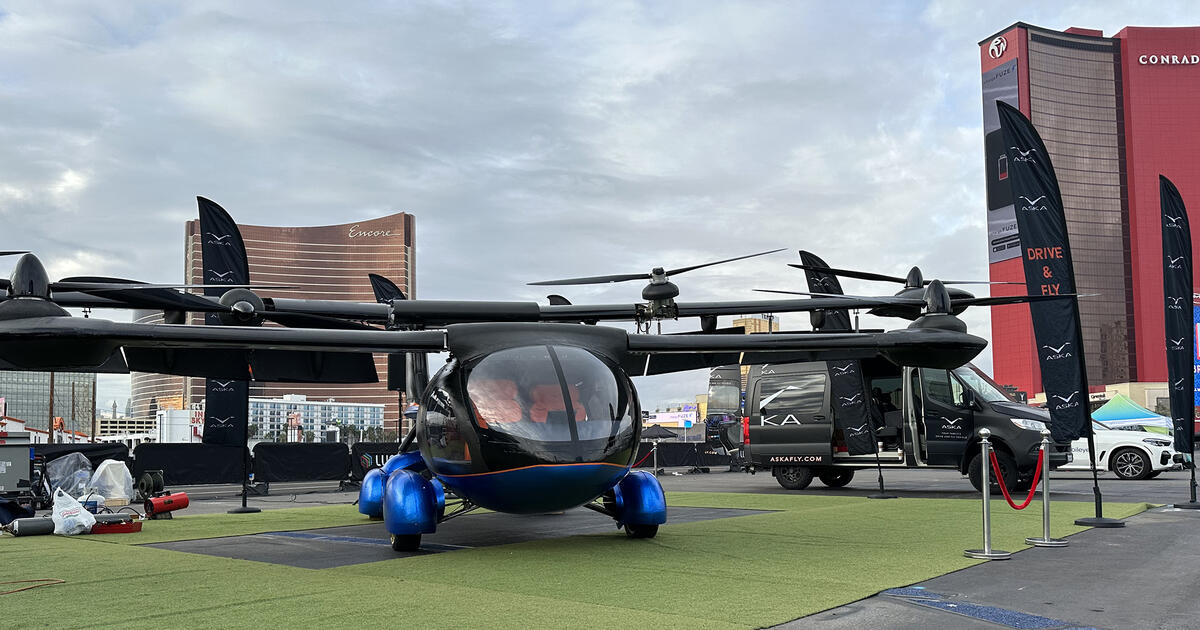New Future Transportation (NFT), the company behind the Aska personal eVTOL aircraft billed as a “flying SUV,” now says it plans to start offering on-demand air taxi services as early as 2026. However, recently announced plans are based on arrangements that would appear to stretch the current regulatory requirements for commercial flights by building on current practices in the ground-based ride-sharing sector.
The California-based start-up unveiled the four-seat, hybrid-electric Aska A5 “drive-and-fly” eVTOL vehicle in April 2021, when it began collecting pre-orders from private buyers. With four motorized wheels and foldable wings, NFT says the Aska will be able to quickly switch between driving and flying modes, and it’s compact enough to park on a driveway or in a garage.
When NFT debuted the first fully functional Aska prototype at the 2023 Consumer Electronics show in Las Vegas earlier this month, the company officially announced its plans to begin offering an on-demand ridesharing service with its Aska vehicles, with operations expected to start in the San Francisco Bay Area in 2026.
Rather than directly hiring pilots to fly the Aska, NFT plans to rent the aircraft to pilots, similar to how companies like Uber can rent cars to their drivers. According to NFT co-founder and CEO Guy Kaplinsky, a commercially licensed pilot—with a driver’s license—would rent the aircraft for some period of time, whether it’s just for the day or for a month, and use it to pick up passengers and take them to their destinations. Passengers and taxi pilots will use the Aska mobile app to connect for rides, just like with other ridesharing services.
While Aska owners and operators will be required to have at least a private pilot’s license, NFT says the vehicle will be semi-autonomous and relatively simple to operate both on the road and in the air. Eventually, NFT aims to offer a fully autonomous version of the Aska that would not require a pilot to be on board. However, the company doesn’t expect that to be feasible until the 2030s.
Since it remains doubtful that the Aska and other so-called “flying cars” will ever be able to take off and land on roads, pilots will need to drive their passengers to the nearest airport for takeoff and then land at the airport closest to their destination before driving the rest of the way there. The Aska is expected to operate in either eVTOL or eSTOL modes, meaning it can take off and land vertically or conventionally on a short runway at almost any airport. For conventional takeoffs, the aircraft requires just 250 feet of runway, and it can take off in under five seconds.
Taking off and landing like a conventional airplane on a runway helps to save battery, as vertical flight and hover mode requires significantly more power than wing-borne flight. To supply vertical lift, the Aska has six propellers. In the event of an in-flight emergency, the aircraft’s wings will allow it to glide down for a safe landing, but it also has a built-in ballistic parachute that can safely lower the craft when gliding isn’t an option.
The hybrid-electric vehicle mostly runs on battery power, but an added gas engine serves as a range extender that can recharge the batteries while the vehicle is moving. It can visit the same gas stations as normal cars to fuel up, and it uses premium gasoline, Kaplinsky said. On a single charge, the Aska has a range of about 250 miles.
Although NFT had not previously disclosed its plans to operate an air taxi service, Kaplinsky told FutureFlight that the on-demand flights have long been part of the company’s original plans. “At first, the campaign was personal ownership for the early adopters,” Kaplinsky said, but “the major thing in urban air mobility is the adaptation by people,” he added. Offering on-demand flights not only provides an additional revenue stream for NFT, but could also make Aska a more accessible transportation option for those who can’t afford to own one.
“The vehicle is expensive, and not everyone can afford that. And the majority of people don’t need them to be in their garage” for daily use, Kaplinsky said. The Aska is priced at $789,000—which includes the cost of pilot training—and customers interested in purchasing the aircraft can reserve one by placing a refundable $5,000 deposit through the company’s website. So far more than 100 customers have pre-ordered the Aska, according to Kaplinsky.
For the on-demand flights, Kaplinsky said NFT is targeting a price range similar to Uber Black, with rides costing $3 to $4 per mile. Passengers can also bring down the cost by opting to share their ride with other passengers traveling on similar routes, much like how the Uber Pool carpooling option works.
While NFT has said it plans to certify the Aska under the FAA’s Part 23 rules for small aircraft. A Part 135 air carrier certificate will also be required in order to launch the on-demand air taxi service, as is the case with companies such as Joby and Archer. But NFT won’t be applying for the Part 135 certificate itself. Rather, Kaplinsky said, NFT will rely on an as-yet-unnamed outside company to handle the Part 135 operations. It is not clear, for now, what view FAA would take of the proposed NFT business model in which the aircraft would be rented on a short-term basis to its pilots for revenue flights.
Meanwhile, Kaplinsky said NFT is getting close to securing the FAA’s G1 type certification basis approval, and the company plans to begin flight testing the Aska in the first quarter of 2023.
Get the latest news and analysis about emerging aviation technology and business models with
FutureFlight's weekly newsletter.
Thank you for signing up. Your first email will arrive shortly.
Oops! Something went wrong. Please try again.
Copyright © 2023 AIN Media Group, Inc. All Rights Reserved.
Terms of Use/Privacy Policy

